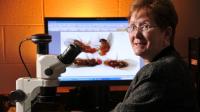
Dr. Trudy Mackay and an international team of researchers provide the holy grail of fruit fly genetics -- a reference panel of genetic variation in 192 fruit fly lines. Scientists searching for the genomics version of the holy grail – more insight into predicting how an animal's genes affect physical or behavioral traits – now have a reference manual that should speed gene discoveries in everything from pest control to personalized medicine.
In a paper published today in Nature, North Carolina State University genetics researchers team with scientists from across the globe to describe the new reference manual – the Drosophila melanogaster Reference Panel, or DGRP. Dr. Trudy Mackay, William Neal Reynolds and Distinguished University Professor of Genetics and one of the paper's lead authors, says that the reference panel contains 192 lines of fruit flies that differ enormously in their genetic variation but are identical within each line, along with their genetic sequence data.
These resources are publicly available to researchers studying so-called quantitative traits, or characteristics that vary and are influenced by multiple genes – think of traits like aggression or sensitivity to alcohol. Mackay expects the reference panel will benefit researchers studying everything from animal evolution to animal breeding to fly models of disease.
Environmental conditions also affect quantitative traits. But studying the variations of these different characteristics, or phenotypes, of inbred fruit flies under controlled conditions, Mackay says, can greatly aid efforts to unlock the secrets of quantitative traits.
"Each fly line in the reference panel is essentially genetically identical, but each line is also a different sample of genetic variation among the population," Mackay says. "So the lines can be shared among the research community to allow researchers to measure traits of interest."
The Nature paper showed that, in general, many genes were associated with three quantitative traits studied in fruit flies – resistance to starvation stress, chill coma recovery time and startle response – and that the effects of these genes were quite large.
"Until now, we had the information necessary to understand what makes a fruit fly different from, say, a mosquito," Mackay says. "Now we understand the genetic differences responsible for individual variation, or why one strain of flies lives longer or is more aggressive than another strain."
Source : North Carolina State University
 Print Article
Print Article Mail to a Friend
Mail to a Friend
